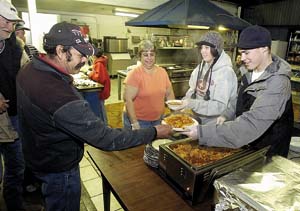HOLLISTER
Five years ago, Gail Baraby had a job and home. But a short while after losing a retail position at Wal-Mart, she and her boyfriend John Wolgamott found themselves living on the street.
Although Baraby can become frustrated with their current position, she said she’s grateful that San Benito County now has a shelter so she can sleep in a bed and get a hot meal during the cold winter months.
“This is quite an improvement to three years ago,” Wolgamott said Friday, speaking about the time before the local shelter had opened. “Plus, in Santa Clara County, there’s no place that has a big screen TV.”
San Benito County’s winter homeless shelter opened the Monday after Thanksgiving, with 12 people staying at the center the first night.
For many of Hollister’s homeless population, the opening of its doors was something to be thankful for with the arrival of the colder winter weather.
Still, Cindy Parr, the new shelter manager, said she hopes it can eventually do more.
“Our focus is to come with a year-round shelter,” Parr said. “Homelessness is not just four months of the year.”
The shelter stays open from the first Monday after Thanksgiving until March 15, providing 24 beds to those age 18 or over – children are not allowed – in need of a place to stay.
Despite hopes to make the shelter year-round, Parr said scarce funds could run out before March.
Right now, they are about $20,000 short on funds, she said.
“We need to come up with the money. We’re coming up with ideas because it’s really not an option to close down in February,” Parr said.
So far, the shelter has been at about half its capacity most nights. Since opening in 2005, there have been 127 people who have registered at the shelter, Parr said.
Parr was happy to see returning faces this year. Friday evening, she ran up to hug and greet one patron in Spanish, who, she explained, had been a regular the previous year but was returning for the first time that night.
Still, she was happy knowing that some who had spent their nights at the shelter in previous years would not be returning. Of those who stayed at the shelter last year, nine are now in apartments, Parr stated proudly.
“We have a pretty high success rate,” she said.
To help nurture the success of those staying at the shelter, guest speakers are brought in to give law advice and other services. On Saturday, Parr said, they were bringing in a hairdresser to cut everyone’s hair.
Wolgamott said he was looking forward to it because his naturally curly hair had become tangled.
On Friday evening, as those staying at the center talked with Parr and other staff outside, a small group of volunteers inside the shelter’s kitchen took turns setting up for dinner.
One volunteer held the large vat of pasta in a marinara sauce while another spooned it into a serving dish.
Myliean Pasillas, 9, was there helping with her church, the Joy Christian Fellowship. She said she enjoyed knowing she was helping others, adding that “it’s fun, because you get to cook and do the napkins.”
Another church member, Diana Velez, said she has been coming to volunteer at the shelter since it opened three years ago.
“The first year I came, I didn’t know what to expect,” she said. “But I really enjoy talking and meeting the people.”
Parr herself started out as a volunteer. She came in late December 2005, but by January, she found herself employed by the shelter
“I brought my kids here to show them what Christmas is all about,” Parr said. “This is a very humbling, a very rewarding experience.”
Since working here, Parr has become close with many of the people who come to the shelter, and this has rubbed off on those around her.
“I want to do more. I don’t want to just come in here and leave,” said Shauna Hoggard, who works at the shelter. “I want to sit with them and talk with them and find out where they grew up.”
Parr said this is key to the staff’s success.
“The only way you can help is to know their stories,” she said.
Wolgamott said a big obstacle to overcome, living on the streets, is how people make assumptions about homeless people.
“A stigma, a stereotype that I would love to stop, is that everybody looks at us like we’re drunks and drug addicts,” Wolgamott said. “We’re not.”
Wolgamott said that the remaining months of the year, he gets money from recycling and doing odd jobs.
“We want to get out of this hole. Once you get yourself dug into this, it’s difficult to get out,” he said.










